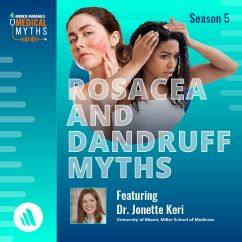(See also Overview of Dermatitis.)
The cause of seborrheic dermatitis is unknown, but reaction to Malassezia yeast, an organism normally present on the skin, may play some role.
Seborrheic dermatitis occurs most often in infants, usually within the first 3 months of life, and in adults 30 to 70 years old.
The risk and severity of the disorder seems to be affected by genetic factors, often runs in families, and is worse in cold weather. Seborrheic dermatitis may be more common and more severe among people who have a neurologic disorder (especially Parkinson disease) and among people who have HIV infection.
Symptoms of Seborrheic Dermatitis
Seborrheic dermatitis usually begins gradually, causing dry or greasy scaling of the scalp (dandruff), sometimes with itching but without hair loss.
In severe cases, yellowish to reddish scaly raised bumps appear along the hairline, behind the ears, on the eyebrows, in the folds of skin on the sides of the nose, and on the chest.
© Springer Science+Business Media
In infants younger than 1 month of age, seborrheic dermatitis may produce a thick, yellow, crusted scalp rash (cradle cap) and sometimes yellow scaling behind the ears and red pimples on the face. Frequently, a stubborn diaper rash accompanies the scalp rash.
Older children and adults may develop a thick, tenacious, scaly scalp rash with large flakes of skin.
Diagnosis of Seborrheic Dermatitis
The location and appearance of the affected skin
Doctors base the diagnosis of seborrheic dermatitis on the location and appearance of the affected skin.
Treatment of Seborrheic Dermatitis
Shampoos, antifungal creams, corticosteroid creams and solutions, and sometimes calcineurin inhibitors
Adults and older children
In adults and older children, the scalp can be treated with a shampoo containing the antifungal medication ketoconazole. Ketoconazole helps control In adults and older children, the scalp can be treated with a shampoo containing the antifungal medication ketoconazole. Ketoconazole helps controlMalassezia yeasts. A ketoconazole shampoo should be used twice a week until symptoms are controlled and then once a week thereafter. Shampoos containing pyrithione zinc, selenium sulfide, salicylic acid and sulfur, or tar are also effective in controlling dandruff and should be used daily or every other day until dandruff is controlled and two times a week thereafter. yeasts. A ketoconazole shampoo should be used twice a week until symptoms are controlled and then once a week thereafter. Shampoos containing pyrithione zinc, selenium sulfide, salicylic acid and sulfur, or tar are also effective in controlling dandruff and should be used daily or every other day until dandruff is controlled and two times a week thereafter.
If the shampoos do not relieve itching, people can apply a corticosteroid solution to the scalp. Seborrheic dermatitis in beard and eyebrow areas is treated similarly to seborrheic dermatitis of the scalp.
Corticosteroid products are also used on the head and other areas. In areas of the face, only mild corticosteroids, such as 1 to 2.5% hydrocortisone cream, should be used. Even mild corticosteroids must be used cautiously, because long-term use can thin the skin and cause other problems. Ketoconazole cream or another antifungal cream may be given for mild cases. Corticosteroid products are also used on the head and other areas. In areas of the face, only mild corticosteroids, such as 1 to 2.5% hydrocortisone cream, should be used. Even mild corticosteroids must be used cautiously, because long-term use can thin the skin and cause other problems. Ketoconazole cream or another antifungal cream may be given for mild cases.
Calcineurin inhibitors (pimecrolimus and tacrolimus) are also used, particularly when long-term therapy is needed and when antifungals alone are not sufficiently effective.Calcineurin inhibitors (pimecrolimus and tacrolimus) are also used, particularly when long-term therapy is needed and when antifungals alone are not sufficiently effective.
Often, treatment must be continued for many weeks. If seborrheic dermatitis returns after the treatment is stopped, treatment can be restarted.
Infants and young children
In infants, the scalp can be shampooed daily with mild baby shampoo, and 1 to 2.5% hydrocortisone cream or fluocinolone oil can be rubbed into the scalp or face. Antifungal creams such as 2% ketoconazole or 1% econazole can be helpful in severe cases. In infants, the scalp can be shampooed daily with mild baby shampoo, and 1 to 2.5% hydrocortisone cream or fluocinolone oil can be rubbed into the scalp or face. Antifungal creams such as 2% ketoconazole or 1% econazole can be helpful in severe cases.
For young children who have a thick scaly rash on the scalp, mineral oil, olive oil, or a corticosteroid gel or oil can be rubbed gently into the affected area with a soft toothbrush at bedtime. The scalp can be shampooed daily until the thick scale is gone. For young children who have a thick scaly rash on the scalp, mineral oil, olive oil, or a corticosteroid gel or oil can be rubbed gently into the affected area with a soft toothbrush at bedtime. The scalp can be shampooed daily until the thick scale is gone.
Drugs Mentioned In This Article





